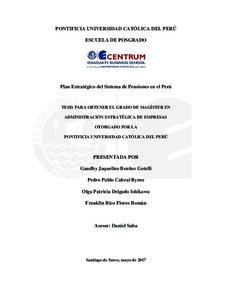| dc.contributor.advisor | Saba de Andrea, Daniel Antonio | |
| dc.contributor.author | Benites Gotelli, Gaudhy Jaqueline | es_ES |
| dc.contributor.author | Cabral Byrne, Pedro Pablo | es_ES |
| dc.contributor.author | Delgado Ishikawa, Olga Patricia | es_ES |
| dc.contributor.author | Flores Román, Franklin Rico | es_ES |
| dc.date.accessioned | 2017-07-11T19:15:41Z | |
| dc.date.available | 2017-07-11T19:15:41Z | |
| dc.date.created | 2017 | |
| dc.date.issued | 2017-07-11 | |
| dc.identifier.uri | http://hdl.handle.net/20.500.12404/8950 | |
| dc.description.abstract | El objetivo principal del «Plan estratégico del sistema de pensiones en el Perú» es
promover su competitividad para mejorar los servicios a la población. Se plantea como visión
que al año 2026 sea un sistema de pensiones que incluya a toda la población peruana en edad
de jubilación (a través de aportes del Estado y contribuciones individuales), siendo eficaz en
la obtención de rentabilidad a largo plazo (mediante una gestión adecuada del riesgo) y
eficiente en sus gastos de administración. Para el logro de esta visión, se plantearon objetivos
de corto y largo plazo que buscan incrementar la tasa de reemplazo promedio, y la cantidad
de personas que reciben una pensión.
En la elaboración del análisis externo, se identificaron como oportunidades: el
crecimiento económico del país y de la PEA ocupada, así como la libertad de iniciativas
estatales, privadas y/o mixtas; y como amenazas: la informalidad laboral, los cambios en la
legislación y el bajo nivel educativo. En el análisis interno, se identificó que las
administradoras de fondos tienen altas rentabilidades; y como debilidades: el bajo nivel de
cobertura, la disminución de la rentabilidad de los fondos y el bajo número de empresas que
conforman el sistema.
Luego del análisis, se definieron como estrategias: crear un sistema mixto en donde el
sector público cumpla un rol subsidiario; y el sector privado, de administración de fondos.
Asimismo, retrasar la jubilación, el cobro de comisiones en función de la rentabilidad, definir
una pensión mínima y aporte de trabajadores independientes, e integración de otras entidades
financieras.
Se recomienda que la implementación de este plan sea liderada por la Presidencia del
Consejo de Ministros (PCM), en coordinación con el Congreso de la República y la
Superintendencia de Banca y Seguros (SBS), revisando las buenas prácticas de los mejores
sistemas de pensiones clasificados en el Global Mercer Pension Index, y solicitando
esfuerzos al Estado para combatir la informalidad, que limita el acceso de las personas a una
pensión | es_ES |
| dc.description.abstract | The main objective of the “Strategic Plan of the Pension System in Peru” is to
promote the competitiveness of this sector to improve services of pension to the population.
By the year 2026, it is proposed as a vision that Pension System in Perú include all the
Peruvian population in retirement age (with state payments and individual contributions),
being effective in obtaining long-term profitability (through appropriate risk management),
and efficient in the costs of administration. To achieve this vision, short-term and long-term
objectives were proposed that seek to increase the average replacement rate, and the number
of people receiving a pension.
In the external analysis, the following opportunities were identified: the economic
growth of the country and the occupied EAP, as well as the freedom of state, private and / or
mixed initiatives; and as threats: labor informality, changes in legislation and low educational
level. In the internal analysis, it was identified that pension funds administrators have high
returns; and as weaknesses: the low level of coverage, the decrease in the profitability of
funds and the low number of companies that make up the system.
After the analysis, the following strategies were defined: creating a mixed system in
which the public sector plays a subsidiary role; and the private sector manages the funds.
Also retirement should be retarded, the commissions should be based on profitability, should
be defined the minimum pension and contribution of the self-employed, and other financial
institutions should be included.
It is recommended that the implementation of this plan be led by the Presidency of the
Council of Ministers (PCM), in coordination with the Congress of Perú and the SBS,
reviewing the best practices of the best pension systems classified in the Global Mercer
Pension Index, and asking the Peruvian State to combat informality, which limits people’s
access to a pension | es_ES |
| dc.language.iso | spa | es_ES |
| dc.publisher | Pontificia Universidad Católica del Perú | es_ES |
| dc.rights | info:eu-repo/semantics/openAccess | es_ES |
| dc.rights.uri | http://creativecommons.org/licenses/by-nc-nd/2.5/pe/ | * |
| dc.subject | Sistema de pensiones -- Perú | es_ES |
| dc.subject | Planificación estratégica | es_ES |
| dc.title | Plan estratégico del sistema de pensiones en el Perú | es_ES |
| dc.type | info:eu-repo/semantics/masterThesis | es_ES |
| thesis.degree.name | Maestro en Administración Estratégica de Empresas | es_ES |
| thesis.degree.level | Maestría | es_ES |
| thesis.degree.grantor | Pontificia Universidad Católica del Perú. CENTRUM | es_ES |
| thesis.degree.discipline | Administración Estratégica de Empresas | es_ES |
| renati.discipline | 413307 | es_ES |
| renati.level | https://purl.org/pe-repo/renati/level#maestro | es_ES |
| renati.type | https://purl.org/pe-repo/renati/type#tesis | es_ES |
| dc.publisher.country | PE | es_ES |
| dc.subject.ocde | https://purl.org/pe-repo/ocde/ford#5.02.04 | es_ES |






